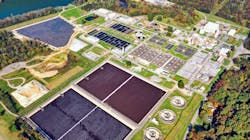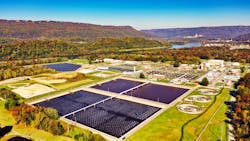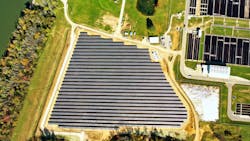Plant profile: Moccasin Bend Environmental Campus
In 1969, CBS television news anchor Walter Cronkite declared Chattanooga the “Dirtiest City in America,” due to the environmental impacts from local industry.
Now, Chattanooga serves as a role model for other municipalities, having recently received a U.S. Department of Energy (DOE) Energy Efficiency Leadership Award for projects at its Moccasin Bend Environmental Campus (MBEC). These projects have yielded successful energy, water and cost savings measures for MBEC.
Chattanooga had joined the DOE Better Buildings Challenge in 2015 and subsequently reduced its energy usage by 23%, from a 2013 baseline of 541,748,000 kBTUs, in just four years, meeting its goal six years ahead of schedule, according to DOE.
The system also encompasses a combined wastewater collection area in a four-square mile part of the downtown Chattanooga.
“Chattanooga being an older city, we also have our share of I&I in the collection system,” Heinzer said. “During a rain event, our peak capacity at the wastewater treatment plant is 230 million gallons daily (MGD).
The operation consists of an activated sludge plant that includes primary clarification.
“We have a pure oxygen UNOX system, secondary clarification, and chlorine disinfection at the back end,” Heinzer said, adding there is also a wet weather treatment train to accommodate the significant flow variation. “We got primary and then disinfection on the wet weather side that will then mix in with the full treated side before it exits the plant. Sampling happens after that,” Heinzer said.
Bringing down bills
One of the major motivators for system improvements at the facility was the $300,000 monthly electric bill.
In order to bring down the facility’s significant energy use, it installed a 10-acre solar farm with a four-megawatt system in 2020. The solar farm provides about 12% of the plant’s energy needs.
That first project attracted attention from DOE and others, he adds.
A 20-year-old filter press building for handling biosolids also was consuming significant energy.
“We were able to retool some of our other processes at the plant here to where we didn’t need that anymore,” said Heinzer.
As a result, the filter press building was decommissioned. Removing power from the press saved the operation tens of thousands of dollars in electricity bills throughout the year.
Another project, currently under construction, is an efficiency upgrade for the 70-million-gallon equalization basin on the campus.
Previously, the entire 70 million gallons on 10 acres would have to be aerated, which was a significant energy draw
“We are now able to partition that into four equal quadrants. We only need to keep the one quadrant aerated at a time,” Heinzer said. “When wet weather comes, we can fill the other three quadrants at that point. . . By reducing that from a full 70 million gallons down to a quarter of that as far as the aeration demand, it is going to be a huge benefit from a power consumption standpoint.”
While the system changes do provide operational resiliency, they are primarily intended to defray energy costs.
“We do have backup energy sitting on power systems for most of our critical components,” says Heinzer. “We’ve got backup generators we use if needed and dual feeds to the plants. If one feed goes down from the grid, we have another backup feed.
Heinzer says the operation flares off the gas coming off of its six digesters.
Chattanooga had a system years ago that provided capture. However, that system aged out and has not been replaced. Consideration is being given to a thermal hydrolysis process to generate more of that gas.
“We generate a certain amount, but we’re not digesting everything right now,” Heinzer said. “We hope to be able to feed a lot more of our solids into the digesters, get more of that gas out and use that in several ways.”
That could entail using it to generate power at the plant or feeding it into the gas pipeline grid for renewable energy credits.
Heinzer noted the biggest challenge his department faced in executing these projects was maintaining operations. It required coordination among the contractors, maintenance staff and operations staff.
“If power needed to be shut off or a facility taken out of operation, then backup power was provided or bypass pumping was installed ahead of time,” says Heinzer.
Because of the combined collection system, wet weather events had to be closely monitored and planned in advance.
“The main goals were to prevent permit violations and potential sanitary sewer overflows while at the same time accommodating the construction,” Heinzer said.
He advised municipalities considering similar projects that careful scheduling and communication across all disciplines is a must.
“Some of the best input we get is from our operators and mechanics who know the process and the sensitivity of the system very well,” Heinzer said. “Bringing them into the initial discussions, as well as including them on plan review, has resulted in us getting a better product in the end.”
Being able to explain to elected officials the benefits in terms that make sense to them is important as well, Heinzer added.
“Many of these projects have a long life and/or ROI that needs to be explained as well as always demonstrating how the projects represent the best use of public funds and show good stewardship for the customers and taxpayers,” he said.
Watch the video
Watch an interview with Mark Heinzer at https://www.wwdmag.com/33001207
Get Your plant profiled!
Share your successes and tell us why your plant is exceptional at https://www.wwdmag.com/ plant-profile-submission-form.
About the Author
Carol Brzozowski
Carol Brzozowski is a freelance writer for Wastewater Digest. Brzozowski can be reached at [email protected].




